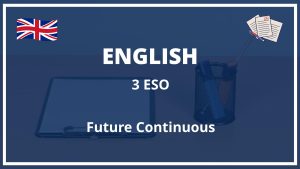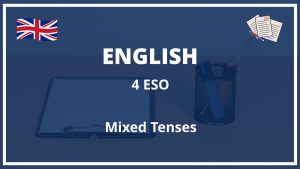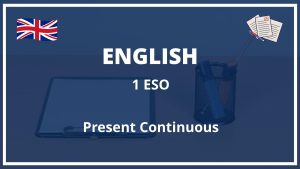
Abrir Ejercicios Present Continuous 2 ESO | Exercices
The Present Continuous is a verb tense which is used to show that an ongoing action is happening now, either at the moment of speaking or now in a larger sense. The Present Continuous can also be used to show that an action is going to take place in the near future.
We make the Present Continuous with the present tense of the verb be plus the -ing form of the main verb:
- I am watching television.
- You are drinking coffee.
- He is playing tennis.
- We are having lunch.
- They are doing the shopping.
The Present Continuous of be is irregular:
- I am
- you are
- he/she/it is
- we/you/they are
We use the Present Continuous to talk about:
- Actions happening now
- Look! He is kissing her!
- Are you listening to me?
- Arrangements for the future
- We are meeting at the conference centre at 9 o’clock tomorrow morning.
- I am not working tomorrow.
- Temporary situations
- I’m living in London at the moment. I’m staying with some friends.
- Changes happening now or in the near future
- Prices are going up.
- The company is moving to new offices in the city centre.
We also use the Present Continuous to talk about what we are doing now:
- I am writing a report.
- You are not listening!
- What are you doing?
Ejercicios Resueltos Present Continuous Ingles 2 Eso
Hay muchos ejercicios de Present Continuous en inglés para el nivel 2 de ESO, y aquí están algunos de ellos resueltos para que puedas practicar y mejorar tu gramática. Recuerda que el Present Continuous se usa para hablar de acciones que están pasando en el momento en que hablamos, o que van a pasar en un futuro muy próximo. También se usa para hablar de hábitos y rutinas. ¡Mucha suerte con los ejercicios!
Ejercicio 1: Completa las frases con la forma correcta del verbo to be en Present Continuous. Recuerda que este verbo se conjuga de la siguiente manera:
- I am (yo soy/estoy)
- You are (tú eres/estás)
- He/She/It is (él/ella/ello es/está)
- We/You/They are (nosotros/nosotras somos/estamos; ustedes son/están; ellos/ellas son/están)
Ejemplo:
I am eating an apple.
Respuesta:
I am eating an apple.
-
You ______________ very happy today.
-
I ______________ not feeling very well.
-
They ______________ playing tennis at the moment.
-
We ______________ going to the cinema tonight.
-
She ______________ working in a bank.
-
I ______________ not doing anything at the moment.
Ejercicio 2: Escribe las frases del ejercicio anterior en negativo. Recuerda que para hacer una frase negativa en Present Continuous, necesitas añadir la forma negativa del verbo to be, que es not.
Ejemplo:
You are very happy today.
Respuesta:
You are not very happy today.
-
You ______________ very happy today.
-
I ______________ not feeling very well.
-
They ______________ playing tennis at the moment.
-
We ______________ going to the cinema tonight.
-
She ______________ working in a bank.
-
I ______________ not doing anything at the moment.
Ejercicio 3: Escribe las frases del ejercicio anterior en interrogativo. Recuerda que para hacer una frase interrogativa en Present Continuous, necesitas poner el verbo to be delante del sujeto.
Ejemplo:
You are very happy today.
Respuesta:
Are you very happy today?
-
______________ you very happy today?
-
______________ I not feeling very well?
-
______________ they playing tennis at the moment?
-
______________ we going to the cinema tonight?
-
______________ she working in a bank?
-
______________ I doing anything at the moment?
Ejercicio 4: Escribe las frases del ejercicio 1 en interrogativo.
Ejemplo:
You are very happy today.
Respuesta:
Are you very happy today?
-
______________ you ______________ very happy today?
-
______________ I ______________ not feeling very well?
-
______________ they ______________ playing tennis at the moment?
-
______________ we ______________ going to the cinema tonight?
-
______________ she ______________ working in a bank?
-
______________ I ______________ not doing anything at the moment?
Ejercicio 5: Escribe las frases del ejercicio anterior en negativo.
Ejemplo:
Are you very happy today?
Respuesta:
You are not very happy today.
-
You are not very happy today.
-
I am not feeling very well.
-
They are not playing tennis at the moment.
-
We are not going to the cinema tonight.
-
She is not working in a bank.
-
I am not doing anything at the moment.
Ejercicio 6: Completa las frases con la forma correcta del verbo entre paréntesis. Recuerda que el Present Continuous se usa para hablar de acciones que están pasando en el momento en que hablamos, o que van a pasar en un futuro muy próximo. También se usa para hablar de hábitos y rutinas.
Ejemplo:
I (eat) an apple.
Respuesta:
I am eating an apple.
-
You (look) very tired.
-
I (not feel) very well.
-
They (play) tennis at the moment.
-
We (go) to the cinema tonight.
-
She (work) in a bank.
-
I (not do) anything at the moment.
Ejercicio 7: Escribe las frases del ejercicio anterior en interrogativo.
Ejemplo:
I am eating an apple.
Respuesta:
Am I eating an apple?
-
______________ you ______________ very tired?
-
______________ I ______________ not feeling very well?
-
______________ they ______________ playing tennis at the moment?
-
______________ we ______________ going to the cinema tonight?
-
______________ she ______________ working in a bank?
-
______________ I ______________ not doing anything at the moment?
Ejercicio 8: Escribe las frases del ejercicio anterior en negativo.
Ejemplo:
Am I eating an apple?
Respuesta:
I am not eating an apple.
-
You are not very tired.
-
I am not feeling very well.
-
They are not playing tennis at the moment.
-
We are not going to the cinema tonight.
-
She is not working in a bank.
-
I am not doing anything at the moment.








